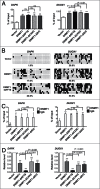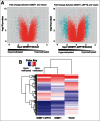RFTS-deleted DNMT1 enhances tumorigenicity with focal hypermethylation and global hypomethylation
- PMID: 25485502
- PMCID: PMC4615144
- DOI: 10.4161/15384101.2014.950886
RFTS-deleted DNMT1 enhances tumorigenicity with focal hypermethylation and global hypomethylation
Abstract
Site-specific hypermethylation of tumor suppressor genes accompanied by genome-wide hypomethylation are epigenetic hallmarks of malignancy. However, the molecular mechanisms that drive these linked changes in DNA methylation remain obscure. DNA methyltransferase 1 (DNMT1), the principle enzyme responsible for maintaining methylation patterns is commonly dysregulated in tumors. Replication foci targeting sequence (RFTS) is an N-terminal domain of DNMT1 that inhibits DNA-binding and catalytic activity, suggesting that RFTS deletion would result in a gain of DNMT1 function. However, a substantial body of data suggested that RFTS is required for DNMT1 activity. Here, we demonstrate that deletion of RFTS alters DNMT1-dependent DNA methylation during malignant transformation. Compared to full-length DNMT1, ectopic expression of hyperactive DNMT1-ΔRFTS caused greater malignant transformation and enhanced promoter methylation with condensed chromatin structure that silenced DAPK and DUOX1 expression. Simultaneously, deletion of RFTS impaired DNMT1 chromatin association with pericentromeric Satellite 2 (SAT2) repeat sequences and produced DNA demethylation at SAT2 repeats and globally. To our knowledge, RFTS-deleted DNMT1 is the first single factor that can reprogram focal hypermethylation and global hypomethylation in parallel during malignant transformation. Our evidence suggests that the RFTS domain of DNMT1 is a target responsible for epigenetic changes in cancer.
Keywords: COSMIC, catalog of somatic mutation in cancer; DNA methylation; DNMT1; DNMT1, DNA methyltransferase 1; HELP, HpaII tiny fragment enrichment by ligation-mediated PCR; KEGG, Kyoto Encyclopedia of Genes and Genomes; RFTS domain; RFTS, replication foci targeting sequence; TSGs, tumor suppressor genes; chromatin; tumorigenicity.
Figures







Comment in
-
DNMT1-associated DNA methylation changes in cancer.Cell Cycle. 2015;14(1):5. doi: 10.4161/15384101.2014.989963. Cell Cycle. 2015. PMID: 25483051 Free PMC article. No abstract available.
Similar articles
-
The DNA methyltransferase Dnmt1 directly interacts with the SET and RING finger-associated (SRA) domain of the multifunctional protein Uhrf1 to facilitate accession of the catalytic center to hemi-methylated DNA.J Biol Chem. 2014 Jan 3;289(1):379-86. doi: 10.1074/jbc.M113.523209. Epub 2013 Nov 19. J Biol Chem. 2014. PMID: 24253042 Free PMC article.
-
Dual Functions of the RFTS Domain of Dnmt1 in Replication-Coupled DNA Methylation and in Protection of the Genome from Aberrant Methylation.PLoS One. 2015 Sep 18;10(9):e0137509. doi: 10.1371/journal.pone.0137509. eCollection 2015. PLoS One. 2015. PMID: 26383849 Free PMC article.
-
RFTS-dependent negative regulation of Dnmt1 by nucleosome structure and histone tails.FEBS J. 2017 Oct;284(20):3455-3469. doi: 10.1111/febs.14205. Epub 2017 Sep 11. FEBS J. 2017. PMID: 28834260
-
Regulation of the DNA methylation machinery and its role in cellular transformation.Prog Nucleic Acid Res Mol Biol. 2001;69:47-79. doi: 10.1016/s0079-6603(01)69044-5. Prog Nucleic Acid Res Mol Biol. 2001. PMID: 11550798 Review.
-
DNMT1: catalytic and non-catalytic roles in different biological processes.Epigenomics. 2022 May;14(10):629-643. doi: 10.2217/epi-2022-0035. Epub 2022 Apr 12. Epigenomics. 2022. PMID: 35410490 Review.
Cited by
-
Circulating MIR148A associates with sensitivity to adiponectin levels in human metabolic surgery for weight loss.Endocr Connect. 2018 Sep 1;7(9):975-982. doi: 10.1530/EC-18-0205. Endocr Connect. 2018. PMID: 30300537 Free PMC article.
-
DNMT1-associated DNA methylation changes in cancer.Cell Cycle. 2015;14(1):5. doi: 10.4161/15384101.2014.989963. Cell Cycle. 2015. PMID: 25483051 Free PMC article. No abstract available.
-
A Tox21 Approach to Altered Epigenetic Landscapes: Assessing Epigenetic Toxicity Pathways Leading to Altered Gene Expression and Oncogenic Transformation In Vitro.Int J Mol Sci. 2017 Jun 1;18(6):1179. doi: 10.3390/ijms18061179. Int J Mol Sci. 2017. PMID: 28587163 Free PMC article. Review.
-
KRAS-driven miR-29b expression is required for tumor suppressor gene silencing.Oncotarget. 2017 Aug 19;8(43):74755-74766. doi: 10.18632/oncotarget.20364. eCollection 2017 Sep 26. Oncotarget. 2017. PMID: 29088821 Free PMC article.
-
Suppression of TET1-dependent DNA demethylation is essential for KRAS-mediated transformation.Cell Rep. 2014 Dec 11;9(5):1827-1840. doi: 10.1016/j.celrep.2014.10.063. Epub 2014 Nov 26. Cell Rep. 2014. PMID: 25466250 Free PMC article.
References
-
- Robertson KD. DNA methylation and human disease. Nat Rev Genet 2005; 6:597-610; PMID:16136652; http://dx.doi.org/10.1038/nrg1655 - DOI - PubMed
-
- Issa J-P. CpG island methylator phenotype in cancer. Nat Rev Cancer 2004; 4:988-93; PMID:15573120 - PubMed
-
- Belinsky SA. Gene-promoter hypermethylation as a biomarker in lung cancer. Nat Rev Cancer 2004; 4:707-17; PMID:15343277; http://dx.doi.org/10.1038/nrc1432 - DOI - PubMed
-
- Jones PA, Baylin SB. The fundamental role of epigenetic events in cancer. Nat Rev Genet 2002; 3:415-28; PMID:12042769 - PubMed
-
- Feinberg AP, Gehrke CW, Kuo KC, Ehrlich M. Reduced genomic 5-methylcytosine content in human colonic neoplasia. Cancer Res 1988; 48:1159-61; PMID:3342396 - PubMed
Publication types
MeSH terms
Substances
Grants and funding
LinkOut - more resources
Full Text Sources
Other Literature Sources
Molecular Biology Databases
